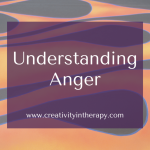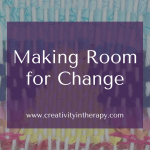
I have another guest post to share with you – Kathryn explains how to create easy finger puppets to explore emotions. I have often done different emotion masks with clients, but I think these finger puppets are great for adding a playful element that would engage some clients better, especially the younger ones. These emotion puppets seem like a great tool for helping kids practice listening to what their different parts/feelings have to say.
Hi everyone! My name is Kathryn, and I’m an art and play therapist from the Comox Valley, BC and author of Visitors: A Book About Feelings.
I wanted to show everyone a really quick art therapy activity that supports emotional literacy and regulation.
You just need four simple materials: a pair of scissors, felt, a glue gun, and a marker.
Step 1: Gather your materials!
Step 2: Trace your finger twice on the felt and cut it out.
Step 3: Glue along the outside with the hot glue gun and press the sides together. Make sure your finger fits inside!
Step 4: Take another small piece of felt and draw out a face. Choose any emotion you like! Now’s the perfect time to check-in with the kiddo you’re with to ask them how they’re feeling or what emotion they would like express. Kids will often choose happy, so I take this opportunity to expand their emotional vocabulary and tolerance for more difficult emotions and choose either sad, angry, worried, or disgusted.
Step 5: Cut and glue the face onto the finger puppet.
Step 6: Add any other embellishments! You can add arms or legs or even pipe cleaner hair!
Step 7: Create as many emotions as you like! Practice expressing each emotion, switching between them, and have them interact. Create a story together and act out different degrees of emotions from being kind of sad / happy/ angry to extremely sad/ happy/ angry.
Kathryn Schmidt specializes in art and play based therapy for kids and teens with ASD, ADHD, ODD, PDA, anxiety, depression, and behavioural issues. She use a client-centred approach to address therapeutic goals such as increased insight, emotional expression/ regulation, better attachment between caregivers and children, management of symptoms such as stress, as well as increased executive functioning. Kathryn has a BFA from Simon Fraser University (2009) and an MA in Art Therapy from Concordia University (2016). She has also received training in Synergetic Play Therapy. You can visit her website at www.colourwheelarttherapy.com or see more resources at https://linktr.ee/colourwheelarttherapy
This blog is not intended to diagnose or treat any mental health conditions. All directives, interventions, and ideas should be used by qualified individuals within the appropriate bounds of their education, training, and scope of practice. Information presented in this blog does not replace professional training in child and family therapy, art therapy, or play therapy. Art therapy requires a trained art therapist.













TERRIFIC idea! I will try it with my Saturday Art kids. Thank you!
Hello,
Could you provide me with a list of resources that emphasize the expressive arts? Please include any training resources.
Thank you,
Sara Cooney
Therapist
Hi Sarah, There are some books on the Resources tab and I have some trainings on the Courses tab (https://creativityintherapy.com/courses/). The trainings will all be on sale in November if you are on the email list. Cathy Malchiodi offers several trainings through her website as well.